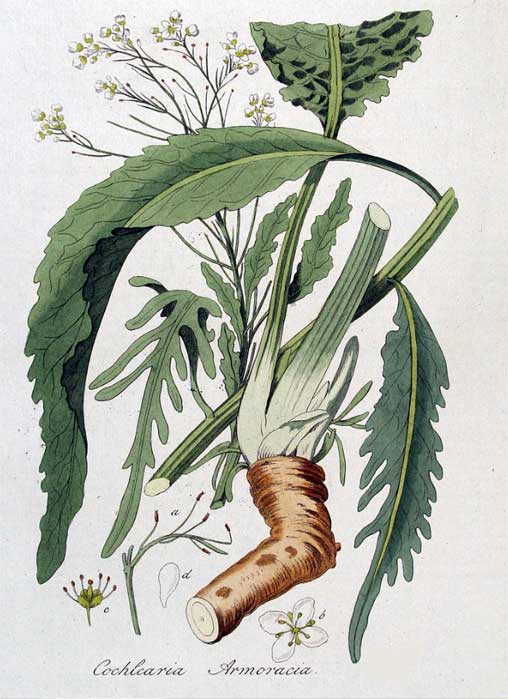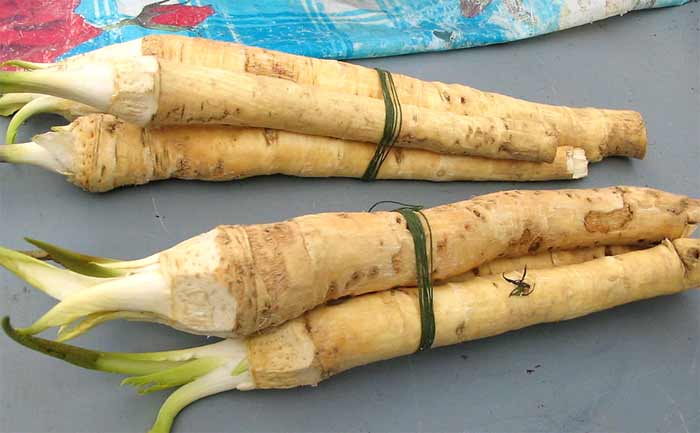Horseradish in herbal medicine
Horseradish (Cochlearia Armoracia) is a condiment like mustard that can clear the sinuses. It makes a flavorful accompaniment for beef, chicken and seafood.

Besides being known as a flavorful culinary herb, horseradish is also a powerful remedy for sinus congestion and other health problems.
Horseradish is considered an excellent herbal medicine for treating everything from asthma to tuberculosis. Horseradish oil contains sulfur which fights bacteria.
It is effective at killing Listeria, E. coli, Staphylococcus and other harmful food bacteria that can cause food poisoning.
Meat and horseradish sauce make an excellent pairing. We like it with roast beef, but it also tastes great in cocktail sauce for dipping shrimp.
Taken with oily fish or rich meat, horseradish acts as a stimulant to the digestive organs.
It helps the body to digest fats after a heavy meal. If you have had your gallbladder removed, eat more horseradish!

Use horseradish for cold and flu congestion.
Horseradish helps clear mucus from the body. It is grated and taken by mouth.
Clear the sinuses with horseradish whenever you have a stopped up nose. The horseradish should be held in the mouth as long as possible. Fumes from the pungent horseradish will penetrate swollen, fluid-filled tissue and cause mucus to run more freely.
When taken for a colds and flu, horseradish clears the nasal passages and promotes restful sleep.
Horseradish has a strong taste.
When the white, fleshy root is grated, a pungent aroma is released. Horseradish also has a hot taste.
During the grating process plant cells are crushed and volatile oils are released.
Vinegar stops this reaction and stabilizes the flavor. For a milder horseradish taste when cooking, vinegar is added immediately after chopping or grating.
Horseradish is a digestive stimulant.
Horseradish has powerful medicinal properties. It acts as a stimulant, diuretic and antiseptic.

Horseradish is a strong diuretic.
Not only does horseradish help move mucus out of the body, it also flushes toxins from the urinary system. Always drink extra water when eating horseradish.
Horseradish was once used by doctors and herbalists in the treatment of dropsy (congestive heart failure).
An infusion was prepared by pouring 1 pint of boiling water over 1 ounce of grated horseradish and 1/2 ounce of crushed mustard seed. The dose was 2 to 3 tablespoons three times a day.
Horseradish works in many ways.
When infused in wine, Horseradish root will stimulate the whole nervous system and promote perspiration. This can help feverish conditions and nervous problems.
Horseradish syrup is very useful in treating hoarseness. Read more about treating throat problems with natural remedies.
If eaten at frequent intervals during the day and at meals, horseradish is said to be effective in getting rid of persistent cough. Take horseradish with wild cherry bark tea for an extra-strength cough remedy!
Horseradish and the skin
An infusion of sliced horseradish in milk is said to make an excellent treatment for skin problems. Do not get horseradish in the eyes!
Horseradish has a long history.
Greeks have been using horseradish since 1500 B.C. They used the herb to treat food poisoning, as a lower back rub, and as an aphrodisiac.
Appointed as one of the five bitter herbs, Jews have used horseradish as part of their religious observance during Passover for centuries.
In Europe during the middle ages, horseradish was used as a cough expectorant and treatment for food poisoning, scurvy, tuberculosis, worms, and colic.

In India, horseradish is used for treating respiratory and urinary infections.
Studies show that horseradish has strong anti-inflammatory properties. It works a lot like ibuprofen and aspirin to heal inflammation and relieve pain.
Collinsville, Illinois is the Horseradish Capitol of the World.
Horseradish is grown in the United States for domestic use and exported to other countries. Collinsville, Illinois is called the Horseradish Capitol of the World and the town hosts a Horseradish Festival every June.
Horseradish is also grown in Wisconsin.
Horseradish likes very rich soil.
Horseradish is a perennial plant that grows up to five feet tall. It likes very rich soil.
Roots with attached crowns are best planted in very early spring. Plant the roots12 to 15 inches deep and 12 to 18 inches apart. Horseradish is easy to grow and may become invasive.
During winter, the crop may be lifted and stored like beets. It is necessary to replant the bed every three or four years to keep the crop from deteriorating.
*Always consult with a healthcare professional before using any herbal remedy especially if pregnant, nursing, or taking other medications.
Sources:
https://www.ncbi.nlm.nih.gov/pmc/articles/PMC5274677/
Blessings to you and yours!
Thanks so much for reading my blog. Jan.

*Note - the information on this website has not been evaluated by the Food and Drug Administration.
© 2005-2024 website design and content by Janice Boling